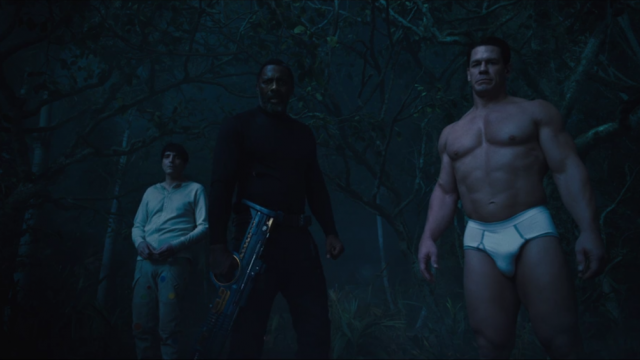There’s a tonal challenge to making fun of superhero tropes while keeping an emotional investment in the characters: Joss Whedon could do it when he prioritized the journeys and interactions of the characters over the jokes; Paul Verhoeven did it in RoboCop by creating a satirical world but playing the hero’s story straight; and James Gunn never did it better than in Super and for the first hour and forty minutes of this (and why would anyone from Troma Films make a longer movie than that?), mainly through his sheer glee not just at sicko imagery (he’s not doing this for our own good, he just loves that shit, God bless him) but at To Live and Die in L. A.-style reversals, where the story goes backwards from what we expect because it goes forward according to what would actually happen with these idiots running around. (Choosing a lot of the second- or third-tier villains from the DC Universe also means he can kill off anyone he damn well chooses.) The Suicide Squad‘s high point comes at around the one-quarter mark, your classic Competitive Team Raid (compare it to the Schwarzenegger/Carl Weathers raid in Predator) with some neat-o kills, self-awareness (“No one likes a showoff.” “Unless what they’re showin’ off is dope as fuck.” “. . .fuck. That’s true”), and a hilariously dark finish.
The cast here is uniformly good and on Gunn’s wavelength, knowing that the performances can’t be naturalistic but need no more than a little bit of madness to join the fun. Best of the lot, easily: John Cena, playing more or less Stupid Captain America, standing tall and proud of everything he does, especially the stupidity (Captain ‘MERICA!, perhaps; his dumbassitude is more American, and much more threatening, than the malevolence of The Boys’ Homelander could ever be), inherently silly in his expressions, posture, and tighty-whities (“now that’s just racist!”), even moreso than Gunn favorite Nathan Fillion. (Did I write this review just to post that screenshot? Perhaps.)
Sadly, as The Suicide Squad goes on, it loses its energy and that James Gunn feeling. (Super went the other way, not only getting crazier as the plot escalated, but taking a surprising turn in the final scenes.) Don’t get me wrong, this isn’t the snoozefest of the earlier version: all through the movie, there’s great imagery, action sequences, genuine comic-book framing (like in Ratcatcher 2’s backstory, another place where Gunn upends an old trope), and jokes that combine all of these, but the demands of too much plot, too many characters, and most of all, too big a spectacle keep weighing down Gunn’s creativity; one measurable sign of this is that Amanda Waller disappears for about half the movie. (Yes, I was saying “where’s Viola Davis?” when she wasn’t on screen.) By the end, when CGI Starro the Conqueror attacks a CGI city with CGI brain slugs until Harley Quinn dives into a CGI eyeball so CGI rats can save the day by attacking a CGI brain, this has become too much like Batman v. Superman, in fact too much like its CGI ending. (Even The Boys did a better job of Destructing the Indestructible Villain with the ol’ jam-a-weapon-in-a-vulnerable-orifice trick, and in its second episode.) It’s not that the ending turns serious (which is a problem that the animated Harley Quinn series sometimes has), it’s that it turns predictable, and the rest of the movie, and Gunn, are not. One more time, from six years ago: scale is the enemy of intensity and spectacle is the enemy of both. In the end, even Gunn can’t win out.
On the other hand, Sylvester Stallone as King Shark says “nom nom.” So, overall, recommended.

